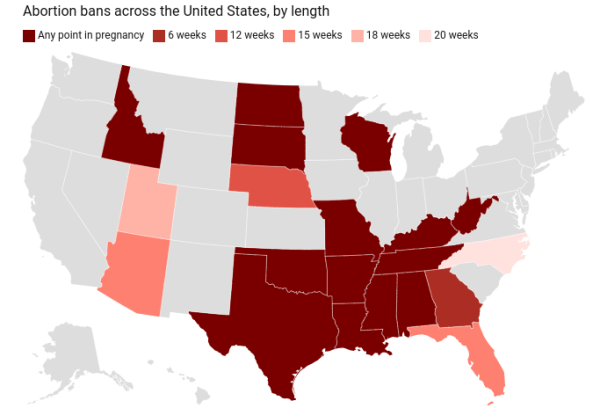
In June 2022, Roe v. Wade was overturned, presenting states with the opportunity to eliminate womens’ rights to abortion. An abortion ends pregnancy early, using medicines to stop the fetus’ growth. This process is medically safe, so many pregnant individuals choose abortion for several reasons.
Currently, in 28 states abortion rights are limited by the stage of the pregnancy. But in 14 states, abortion is completely banned with few exceptions.
As of today, some state governments continue to try to change their bans.
In Florida, many decisions are being challenged. Planned Parenthood along with other abortion-related clinics filed a lawsuit against the 15-week ban, claiming it was unconstitutional. But in a vote of 6 to 1, the conservative Florida Supreme Court voted that it was, in fact, constitutional.
This would later allow for the most current event of abortions to be limited to a 6-week ban. However, in the fall, state inhabitants will be able to vote on the matter.
On the opposing side, Arizona seems to be leaning toward abortion access rather than restriction. This is especially due to its lean towards the Biden Administration which supports abortion rights.
Politicians as individuals often have varying views—not only in the state government but also in federal positions. The current Vice President, Kamala Harris, views the abortion ban as a “health care crisis” while former president Donald Trump claims he will back the 15-week ban if he takes office.
Conservative versus liberal views continue to divide the country and cause conflict.
The political side of reproductive rights is sweeping the nation, but abortions themselves are also a health care and safety matter. Because abortions end pregnancy and stop the fetus’ growth, they can often be a weighty decision for pregnant individuals to make.
Some of the medical reasons to perform an abortion are if the baby can inherit a dangerous genetic disease, if the pregnancy is dangerous or fatal for the mother, or if the baby cannot properly develop.
In addition, there are personal factors that add to the decision to abort. If the pregnancy is a product of rape, many mothers will harbor negative sentiments that could lead to them wanting an abortion.
Individuals’ homes and financial situations could also be major factors in the decision. Early pregnancy or pregnancy during an unstable home or financial situation could hurt the mother, baby, and family, so mothers might decide to abort.
Abortion laws have had a long and rocky road. Often, reproductive health rights correlate with the womens’ movement. Some believe in pro-life, while others believe in pro-choice. Those against abortion or anti-abortion call themselves pro-life; however, pro-choice believes that pregnant individuals should decide for themselves whether they’d like to abort or not.
Governments are putting restrictions on womens’ bodies by limiting their choice, hence the protest: “My body, my choice.” Throughout much of history, women’s health has been ignored. The majority of government positions are held by men, who are unable to become pregnant. According to one government site, ” As of November 28, 2023, there are 126 women in the U.S. House of Representatives (not including four female non-voting delegates), making women 29.0% of the total.” Out of 100 senators, “As of October 3, 2023, there are 25 women (15 Democrats, 9 Republicans, and 1 Independent) serving as U.S. senators. Additionally, Kamala Harris as vice president serves as President of the Senate.Many also lack the knowledge of female biology that doctors and women themselves have” Sp women only make up 25% of the senate. According to the last census, “As of July 1, 2022, there were 165.28 million males and 168 million females living in the United States.”
Women’s health and medicine has also been greatly overlooked in science. For example, the majority of sleep studies have been performed exclusively on men. And most medicines are only tested on and created for the male body. Even many menstrual period products have only recently been tested with real female blood. According to the article, “Sex Inequalities in Medical Research: A Systematic Scoping Review of the Literature” “The gender gap in medical research, alongside overarching misogyny, results in real-life implications for female patients.13 The “Yentl syndrome,” named after the central protagonist in the 19th century story by Isaac Beshevis Singer, is the phrase coined by Dr. Bernadette Healy that describes how, for a woman’s illness to be taken seriously, she must prove herself to be as unwell as a male counterpart.14 Yentl syndrome as a cause of delayed care for female patients is well documented in the medical literature.13 Lack of research evidence from female patients may result in delay in treatment; applying inappropriate, ineffective, or harmful treatments; or the withholding of effective treatments” (Merone).
The basis of the modern medical system is based on male biology, which causes harmful effects on the livelihoods and health of women. Abortion laws are only the most recent layer placed upon years of discrimination against women and the limitations of their health rights.
Sources:
“Facts.” Center for American Women and Politics, https://cawp.rutgers.edu/facts. Accessed 29 April 2024.
Merone L, Tsey K, Russell D, Nagle C. Sex Inequalities in Medical Research: A Systematic Scoping Review of the Literature. Womens Health Rep (New Rochelle). 2022 Jan 31;3(1):49-59. doi: 10.1089/whr.2021.0083. Erratum in: Womens Health Rep (New Rochelle). 2022 Mar 16;3(1):344. PMID: 35136877; PMCID: PMC8812498.
“Senators.” Senate.gov, https://www.senate.gov/senators/. Accessed 29 April 2024.
